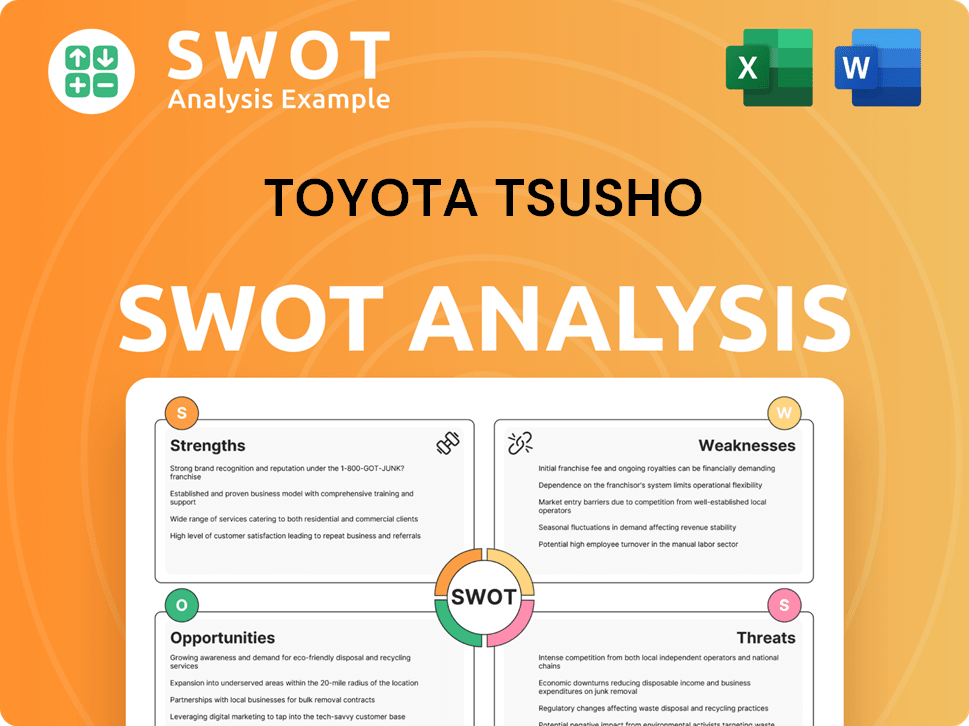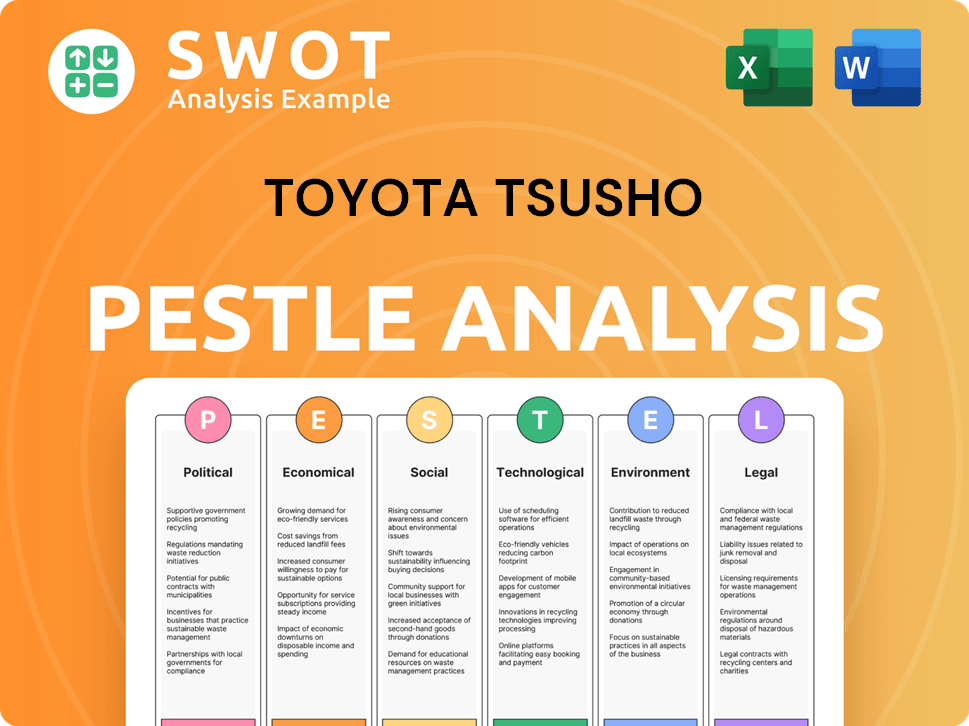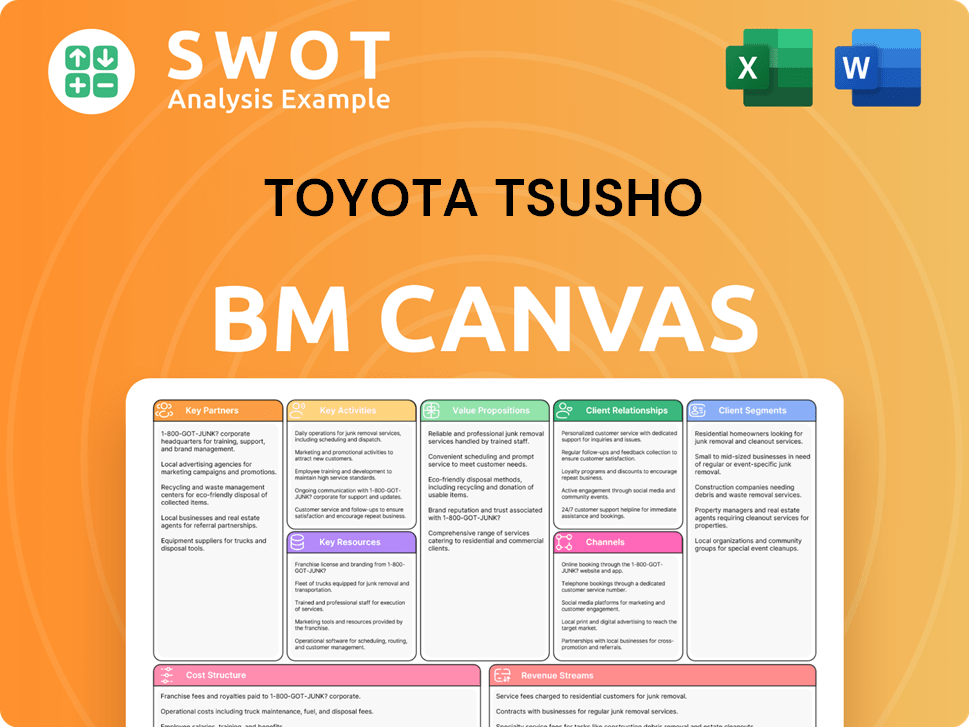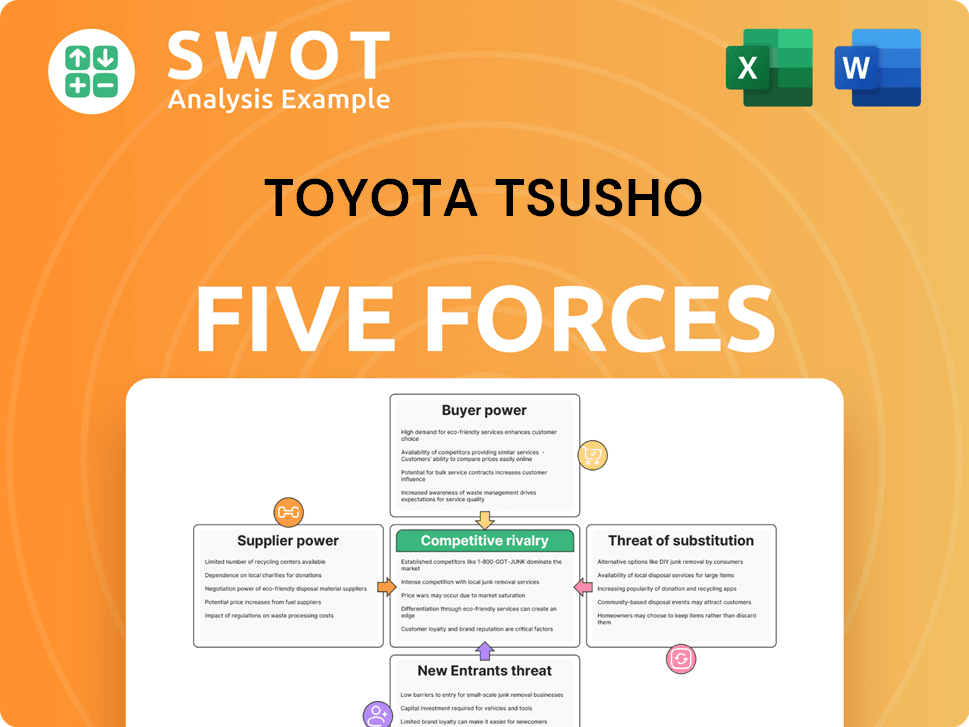Toyota Tsusho Bundle
How Does Toyota Tsusho Navigate the Global Trading Arena?
In the dynamic world of international trade, understanding the competitive landscape is paramount. Toyota Tsusho, a key player within the Toyota Group, operates across diverse sectors, from automotive to energy. This analysis will dissect the Toyota Tsusho SWOT Analysis, revealing its strengths, weaknesses, opportunities, and threats in the global market.

This exploration of the Toyota Tsusho competitive landscape will provide a comprehensive market analysis, examining its key competitors and strategic positioning. We'll delve into Toyota Tsusho's business strategy, evaluating its financial performance and global presence. Furthermore, the analysis will consider challenges in the current market, including its diversification strategy and future outlook, offering insights for investors and business strategists alike.
Where Does Toyota Tsusho’ Stand in the Current Market?
Toyota Tsusho Corporation maintains a strong market position, leveraging its integral role within the broader Toyota Group. The company's consolidated net sales reached ¥9,298.6 billion for the fiscal year ended March 31, 2024, highlighting its significant scale and influence. Its operations span seven key segments: Metals, Global Parts & Logistics, Automotive, Machinery, Energy & Project, Chemicals & Electronics, and Food & Consumer Services, contributing to its comprehensive market standing.
Geographically, Toyota Tsusho has a formidable global presence, with operations in over 120 countries and regions. This extensive network, particularly strong in Asia, Africa, and North America, allows the company to serve a wide array of customer segments. Over time, Toyota Tsusho has strategically shifted its positioning, emphasizing value-added services and sustainable business initiatives. For instance, the company has invested heavily in renewable energy projects and digital transformation initiatives, diversifying its offerings beyond conventional trading activities.
The company's financial health remains robust, supported by its strong balance sheet and consistent profitability. The company holds a particularly strong position in regions where the Toyota Group has a significant manufacturing and sales presence, such as Southeast Asia and Africa, where it plays a critical role in the automotive supply chain and infrastructure development. For a deeper dive into the company's ownership structure and financial performance, consider exploring Owners & Shareholders of Toyota Tsusho.
Toyota Tsusho's diverse operations are organized into seven key segments. These include Metals, Global Parts & Logistics, Automotive, Machinery, Energy & Project, Chemicals & Electronics, and Food & Consumer Services. The Automotive and Metals segments are historically major revenue drivers, contributing significantly to the company's overall financial performance.
The company operates in over 120 countries and regions, showcasing a formidable global presence. Toyota Tsusho's extensive network is particularly strong in Asia, Africa, and North America. This wide geographic reach enables the company to serve a diverse customer base, from large multinational corporations to local enterprises.
Toyota Tsusho has strategically shifted its focus beyond traditional trading. The company emphasizes value-added services, project development, and sustainable business initiatives. Investments in renewable energy and digital transformation initiatives demonstrate a move toward a more integrated and solutions-oriented approach.
Toyota Tsusho's financial health is robust, supported by a strong balance sheet and consistent profitability. The company's consolidated net sales for the fiscal year ended March 31, 2024, were ¥9,298.6 billion. This financial strength allows the company to maintain a competitive edge and invest in future growth opportunities.
Toyota Tsusho's competitive advantages include its strong ties to the Toyota Group, a diversified business model, and a global presence. These factors enable the company to navigate the competitive landscape effectively. The company's focus on value-added services and sustainable initiatives also strengthens its market position.
- Strong relationship with the Toyota Group.
- Diversified business model across multiple sectors.
- Extensive global presence with operations in over 120 countries.
- Focus on value-added services and sustainable initiatives.
Toyota Tsusho SWOT Analysis
- Complete SWOT Breakdown
- Fully Customizable
- Editable in Excel & Word
- Professional Formatting
- Investor-Ready Format

Who Are the Main Competitors Challenging Toyota Tsusho?
The Toyota Tsusho competitive landscape is shaped by a diverse set of rivals across its various business segments. These competitors range from large, diversified trading houses to specialized industry players, each vying for market share and strategic advantage. Understanding these competitors is crucial for a comprehensive Toyota Tsusho market analysis and assessing its business strategy.
Toyota Tsusho industry faces intense competition, requiring continuous adaptation and strategic responses. This environment necessitates a thorough examination of its rivals to understand their strengths, weaknesses, and strategies. For a deeper dive into how the company positions itself, consider exploring the Target Market of Toyota Tsusho.
In the automotive and metals segments, Toyota Tsusho competitors include major Japanese trading companies. These companies, such as Mitsubishi Corporation, Mitsui & Co., Ltd., and Sumitomo Corporation, possess significant global networks and financial backing.
Mitsubishi Corporation competes directly in automotive parts, logistics, and metals trading. It often leverages its group companies and strategic alliances to gain a competitive edge. In the fiscal year 2023, Mitsubishi Corporation reported a net profit of ¥964.5 billion.
Mitsui & Co. also has a substantial presence in automotive and metals, along with investments in energy and infrastructure. Mitsui & Co. reported a net profit of ¥970.5 billion in fiscal year 2023.
Sumitomo Corporation competes across multiple industries, including metals, mineral resources, and automotive. In fiscal year 2023, Sumitomo Corporation’s net profit was ¥750.1 billion.
Beyond the large trading houses, Toyota Tsusho faces specialized competitors in each of its business lines. This includes international energy companies, global distributors, and retail chains.
New players, especially those focused on digital solutions and sustainable technologies, are disrupting the traditional competitive landscape. These companies often challenge established players with innovative approaches.
The competitive dynamics in the Toyota Tsusho competitive landscape are influenced by pricing strategies, innovation, brand recognition, distribution networks, and technological capabilities. Toyota Tsusho financial performance is directly impacted by these factors.
- Aggressive Pricing: Competitors use pricing strategies to gain market share.
- Rapid Innovation: Innovation in specific product areas is a key competitive factor.
- Brand Recognition: Strong brand recognition in niche markets helps competitors.
- Optimized Distribution: Efficient distribution networks are crucial for success.
- Technological Capabilities: Advanced technologies provide a competitive advantage.
Toyota Tsusho PESTLE Analysis
- Covers All 6 PESTLE Categories
- No Research Needed – Save Hours of Work
- Built by Experts, Trusted by Consultants
- Instant Download, Ready to Use
- 100% Editable, Fully Customizable

What Gives Toyota Tsusho a Competitive Edge Over Its Rivals?
The competitive advantages of Toyota Tsusho Corporation stem from its strategic alignment with the Toyota Group, its diversified business model, and its extensive global network. This affiliation provides a solid foundation, especially in the automotive sector, where it benefits from preferred access to Toyota's global supply chain. This relationship is a key element in understanding the Growth Strategy of Toyota Tsusho.
Toyota Tsusho's diversification across seven key segments—Metals, Global Parts & Logistics, Automotive, Machinery, Energy & Project, Chemicals & Electronics, and Food & Consumer Services—mitigates risks associated with industry fluctuations. Its global footprint, operating in over 120 countries and regions, supports a robust distribution network and deep market insights. This extensive network provides a significant barrier to entry for smaller competitors, influencing the overall Toyota Tsusho competitive landscape.
The company leverages its expertise in logistics and supply chain management, developed through its long-standing support of the Toyota Group, to offer efficient services to a broader client base. Proprietary knowledge in areas like resource development, project management, and sustainable energy solutions further differentiates it. The company also emphasizes a culture that values long-term relationships and continuous improvement, fostering strong customer and partner loyalty.
This provides preferred access to Toyota's global supply chain and manufacturing operations. It fosters economies of scale and strong customer loyalty within the automotive sector. This advantage is sustainable due to the enduring strength and global reach of the Toyota brand, influencing the Toyota Tsusho industry.
The diversification across seven key segments mitigates risks associated with fluctuations in any single industry. This model allows for cross-segment synergies and offers resilience against market downturns. This is a key aspect of Toyota Tsusho's business strategy.
Operating in over 120 countries and regions provides a robust distribution network and deep market insights. This extensive network is a significant barrier to entry for smaller competitors. It enables Toyota Tsusho to adapt to local market demands and build strong relationships.
Developed through decades of supporting the Toyota Group, this expertise allows for efficient and reliable services. Proprietary knowledge in areas like resource development and sustainable energy solutions further differentiates the company. This directly impacts Toyota Tsusho's financial performance.
Toyota Tsusho's competitive edge comes from its strong ties to the Toyota Group, a diversified business model, and a vast global network. These factors enable the company to maintain a strong position in the market. The company's financial results and competitive positioning are directly influenced by these advantages.
- Strong relationship with Toyota Motor Corporation providing access to supply chains.
- Diversified operations across various sectors, mitigating risks.
- Extensive global presence with a robust distribution network.
- Expertise in logistics and supply chain management.
Toyota Tsusho Business Model Canvas
- Complete 9-Block Business Model Canvas
- Effortlessly Communicate Your Business Strategy
- Investor-Ready BMC Format
- 100% Editable and Customizable
- Clear and Structured Layout

What Industry Trends Are Reshaping Toyota Tsusho’s Competitive Landscape?
The Toyota Tsusho competitive landscape is significantly shaped by industry trends. The company's Toyota Tsusho industry position is evolving due to global shifts towards sustainability and digital transformation. These trends present both opportunities and challenges for the company's Toyota Tsusho business strategy.
Toyota Tsusho market analysis reveals that geopolitical complexities and trade protectionism are increasing risks. The company must navigate these challenges through risk management and diversified sourcing. The future outlook involves strengthening core businesses and expanding into growth areas, enhancing digital capabilities, and fostering sustainable practices.
The push towards decarbonization and sustainability is driving demand for renewable energy and electric vehicle components. Digital transformation, including AI and IoT, is crucial for enhancing supply chains and developing new services. Geopolitical complexities and trade protectionism pose challenges to global operations.
Investment in new infrastructure and cybersecurity risks are significant challenges in digital transformation. Navigating increasing geopolitical complexities and trade protectionism requires robust risk management. Adapting to the changing landscape necessitates strategic divestment or transformation in traditional fossil fuel-related businesses.
Emerging markets, particularly in Africa and Southeast Asia, offer growth opportunities. Innovations in materials science, smart mobility, and the circular economy provide avenues for new product development. Strategic partnerships and investments in these regions can drive expansion.
Toyota Tsusho is focusing on strengthening core businesses and expanding into new growth areas. It is enhancing digital capabilities and fostering sustainable practices across its value chain. The company aims to become a more integrated, technologically advanced, and sustainability-focused global trading and investment firm.
The company's strategy includes expanding into renewable energy, electric vehicle components, and emerging markets. They are focusing on digital transformation to enhance supply chains and create new digital services. The overall goal is to maintain a competitive edge in a rapidly changing global market. For further insights, you can read a Brief History of Toyota Tsusho.
- Focus on sustainability and decarbonization initiatives.
- Investment in digital transformation and advanced technologies.
- Expansion into emerging markets for growth.
- Strengthening core businesses and enhancing digital capabilities.
Toyota Tsusho Porter's Five Forces Analysis
- Covers All 5 Competitive Forces in Detail
- Structured for Consultants, Students, and Founders
- 100% Editable in Microsoft Word & Excel
- Instant Digital Download – Use Immediately
- Compatible with Mac & PC – Fully Unlocked

Related Blogs
- What are Mission Vision & Core Values of Toyota Tsusho Company?
- What is Growth Strategy and Future Prospects of Toyota Tsusho Company?
- How Does Toyota Tsusho Company Work?
- What is Sales and Marketing Strategy of Toyota Tsusho Company?
- What is Brief History of Toyota Tsusho Company?
- Who Owns Toyota Tsusho Company?
- What is Customer Demographics and Target Market of Toyota Tsusho Company?
Disclaimer
All information, articles, and product details provided on this website are for general informational and educational purposes only. We do not claim any ownership over, nor do we intend to infringe upon, any trademarks, copyrights, logos, brand names, or other intellectual property mentioned or depicted on this site. Such intellectual property remains the property of its respective owners, and any references here are made solely for identification or informational purposes, without implying any affiliation, endorsement, or partnership.
We make no representations or warranties, express or implied, regarding the accuracy, completeness, or suitability of any content or products presented. Nothing on this website should be construed as legal, tax, investment, financial, medical, or other professional advice. In addition, no part of this site—including articles or product references—constitutes a solicitation, recommendation, endorsement, advertisement, or offer to buy or sell any securities, franchises, or other financial instruments, particularly in jurisdictions where such activity would be unlawful.
All content is of a general nature and may not address the specific circumstances of any individual or entity. It is not a substitute for professional advice or services. Any actions you take based on the information provided here are strictly at your own risk. You accept full responsibility for any decisions or outcomes arising from your use of this website and agree to release us from any liability in connection with your use of, or reliance upon, the content or products found herein.